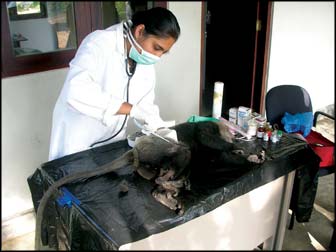Rehab in the wild
Sajitha PREMATUNGE
 Their patients include the Fishing cat, Pangolin, Hog deer, several
Eagle species, Owl species, the Purple faced leaf monkey and even
pythons and other snakes who slither into houses! And the care with
which they are treated is heart warming. Their patients include the Fishing cat, Pangolin, Hog deer, several
Eagle species, Owl species, the Purple faced leaf monkey and even
pythons and other snakes who slither into houses! And the care with
which they are treated is heart warming.
The Hiyare Bio-diversity Education and Research Centre has gone
beyond education and research with their Animal Rehabilitation and
Rescue Programme, a joint venture between the Wildlife Conservation
Society, Galle and the Department of Wildlife Conservation. Although
public contributions of milk foods and medicines are encouraged, the
programme is fully funded by the Nations Trust Bank.
This facility is a fully equipped facility consisting of a library -
accessible to anyone interested in Wildlife conservation - a lab,
dormitory and a lecture hall. “This is the only facility that
rehabilitates and releases animals to the wild except Eth Athuru Sewana”,
said the President of Wildlife Conservation Society, Galle, Madura De
Silva.
The programme treats and rehabilitates wild animals brought to them
by the Zoo or the authorities, while they themselves also engage in
rescue operations closer to the centre.
When they are brought to the centre they are treated by the voluntary
veterinary surgeon of the Galle Wildlife Conservation Society, Devika
Lakmali, then put in rehab and eventually reintroduced into the wild.
But as Madura emphasises they do not translocate. “Injured animals are
rehabilitated and released within close proximity to where they were
originally found.”
“We have a special programme just for the rare Hog deer,” a
critically endangered species whose distribution is limited to Kalutara
and Galle districts. “And even these habitats are under threat from
encroachment for cinnamon plantations.”
 According to law, domesticating wild animals is prohibited. When the
Department of Wildlife seizes these animals they are also brought to the
Hiyare Bio-diversity Education and Research Centre for rehabilitation.
Domesticated animals cannot fend for themselves in the wild. According to law, domesticating wild animals is prohibited. When the
Department of Wildlife seizes these animals they are also brought to the
Hiyare Bio-diversity Education and Research Centre for rehabilitation.
Domesticated animals cannot fend for themselves in the wild.
“In most cases they are reintroduced into the wild without an interim
period of adjustment.” At Hiyare animals are rehabilitated and trained
prior to release and are closely monitored, even afterwards, by the
Society.
The animals in their captive breeding programme are released within
the Hiyare Rain Forest itself. The Hiyare Rain Forest has an extent of
600 acres, managed by the Forest Department and the Municipal Council of
Galle.
The Hiyare Rain Forest and a 50-acre lake on site used for supplying
water to the town of Galle, after abandonment, was entrusted to the
various conservation activities of the Galle Wildlife Conservation
Society, in 2003.
Hiyare is now home to 115 species of birds, 59 species of
butterflies, 39 species of fresh water fish, 57 species of dragon and
Damselflies, 60 species of reptiles and 36 species of mammals.
When a wild animal is injured their only alternative used to be the
zoo, but with the Wildlife Conservation Society of Galle they have a
better chance at being reintroduced into the wild.
|

